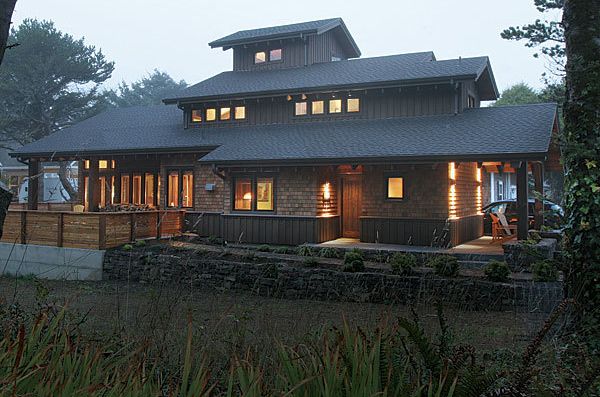Built for Foul Weather
A new home on the Oregon coast blends reclaimed materials with durable details.

Synopsis: When you’re building on the coastline in Oregon, you need to be ready for the most extreme conditions possible. For architect Nathan Good, this project was an opportunity not only to mind potentially harsh conditions but also to work with an assortment of materials reclaimed from a lumber warehouse built in 1938. At about 2200 sq. ft., the timber-frame house achieved a gold LEED rating. The house’s energy-efficient details include exterior walls insulated with both spray foam and blown-in fiberglass; low-e windows; an air-to-water heat pump; an efficient wood-burning fireplace that serves as a backup heat source; and a Zehnder heat-recovery ventilator. Because the house is built close to the shore, the side of the house facing the Pacific was built with a 4-ft.-high concrete wall to protect the home from surges and impact from debris.
The Pacific Coast is a beautiful, brutal place to build. The weather along the Oregon coast is particularly tough on dwellings. It is not uncommon for there to be 70 in. to 90 in. of rain per year. High winds pound rain at windows and cladding. Salt-laden air silently chews away at exposed metal surfaces. Water and vapor seek to infiltrate houses, launching colonies of mold and reducing the effectiveness of insulation. Earthquakes, tsunamis, and fires all patiently await their turn to deliver unexpected damage.
On a 50-ft. by 100-ft. lot a block from the ocean in the quaint village of Neskowin, my clients wanted a home that would be comfortable when they were alone or with family and friends, and that would highlight large amounts of reclaimed Douglas-fir lumber. Above all, they wanted a place to withstand the punishment that such a harsh environment can deliver.
Hybrid construction: A mix of old and new
The choice of materials used to build this house is a reflection of my clients’ love of old wood buildings, barns, mining structures, and historic lodges, and of their passion for their family heritage. Terry was raised in the lumber industry, eventually managing his family’s lumber business. He and his wife, Teresa, obtained a substantial portion of the wood for their house from the deconstruction of a 1938 warehouse on the family’s property. The salvaged Douglas fir was used for columns and beams, roof framing, flooring, cabinetry, wall paneling, doors, interior trim, and some of the home’s furniture. Even the hardware and fasteners from the old structure were reused as cabinet handles, towel bars, and drawer pulls, and for a beautifully crafted balcony railing that was designed by the family.
An early challenge for the design-build team was figuring out how to leave the underside of the roof structure exposed. To highlight the salvaged Douglas-fir roof, ceiling joists, and massive beams, we set 7 in. of polyiso rigid-foam insulation above the structural sheathing, resulting in an R-value of roughly 46. All the seams in the insulation were staggered and sealed with flashing tape to prevent air and vapor movement through the roof. To accentuate the salvaged wood further, we placed 3⁄4-in.-thick reclaimed boards under the 1⁄2-in. plywood roof sheathing. This type of assembly enables the sought-after look of an exposed roof structure while maintaining the high-performance demands of a modern home.
The exterior walls, which are composed of 2×6 studs and filled with a 2-in. flash coat of closed-cell spray foam and 3-1⁄2 in. of Johns Manville blown-in Spider formaldehyde-free fiberglass, are a bit more conventional and mostly finished with drywall. A 1⁄2-in.- thick layer of XPS rigid foam was applied to the exterior under a rainscreen to break the thermal bridging of the wood framing; this brought the wall assembly up to R-30. Many of the interior walls, however, are finished with rough-sawn Douglas-fir boards. The house’s enhanced insulation package cost approximately $8000 more than a house that is built to current Oregon Energy Code standards.
For more photos and details, click the View PDF button below:
Fine Homebuilding Recommended Products
Fine Homebuilding receives a commission for items purchased through links on this site, including Amazon Associates and other affiliate advertising programs.

Smart String Line

The New Carbon Architecture: Building to Cool the Climate

A Field Guide to American Houses


























